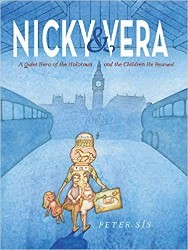Most American readers likely identify Judith Kerr with her semi-autobiographical children’s novel, When Hitler Stole Pink Rabbit. Kerr’s reputation in Britain as an author and illustrator of children’s books, unrelated to her story as a Jewish child fleeing Nazi Germany, is more definitive of her career and her legacy. Thames and Hudson has honored this artistic legacy by dedicating the second volume of their series, The Illustrator, to Kerr, who died in May of 2019. The elegantly designed retrospective traces Kerr’s early life, artistic influences, and professional development from her birth in Berlin in 1923, to the still productive period of her late life. Readers will gain a deep appreciation of Kerr’s artistic vision, as well as her integration of family with career in an earlier era.
Kerr was born into an educated Jewish family in Berlin; her father, Alfred Kerr, was a respected theater critic and journalist whose career was destroyed as the Nazis took power. He and his family were able to escape, resettling in Switzerland, France, and eventually, England. Many of Judith Kerr’s early drawings are reproduced in the book, showing the continuity of her meticulous approach to depicting the human form. As a young adult she would take life drawing classes in London, later reflecting that the knowledge she gleaned there became a permanent and essential part of her consciousness. Author Joanna Carey’s respect for the specific elements of Kerr’s artistic process comes through in her prose; she compares Kerr’s reverence for different types of pencils to that of a sommelier for fine wines. Observing animals on visits to the zoo with her young daughter, Kerr discovered that watercolor paints were inadequate for capturing what she had seen, leading her to discover the value of layering colored inks for converting a family outing into the universal experience encapsulated in a picture book.
That picture book became Kerr’s The Tiger Who Came to Tea (1968), in which the title character interrupts the calm domesticity of a little girl named Sophie, curling up on top of a refrigerator and drinking out of the kitchen sink’s faucet while Sophie fearlessly holds onto its tail. This quintessential account of an orderly British routine upended by the entrance of something wild and uncontrollable was actually created by an immigrant who had fled chaos, an interesting note considering the book’s huge success. Carey does not emphasize this implicit element, repeating Kerr’s own skepticism about deep metaphors in the story. In fact, there is some tension throughout this biography between the facts of its subject’s early life and the author’s insistence that Kerr’s childhood had been a series of near disasters which were tidily avoided. Kerr herself generally articulated this perspective, emphasizing her easy assimilation into a new culture and her comfort with its values. Yet there is some dissonance in reading Carey’s account of the family’s escape as a “huge adventure.” Carey describes a mournful drawing which Kerr produced at the age of ten, in which a classroom of children in Switzerland are cheerfully interacting, while one girl sits alone weeping. The author analyzes the picture’s technique but seems uneasy confronting the reality of its meaning: “Again, there is a strong sense of storytelling, and one cannot help wondering what is going on.” Towards the end of the book, Carey connects Kerr’s constant revisions of her work to Alfred Kerr’s own losses, interpreting the artist’s perfectionism as an inheritance from her father, who “was still both correcting and rewriting his own work after it was published — and even after the Nazis had had all his books publicly burnt.” Kerr’s father’s literary legacy can be seen to illuminate a great deal about her own need for artistic control.
Kerr followed When Hitler Stole Pink Rabbit (1971) with two sequels, Bombs on Aunt Dainty (1975) and A Small Person Far Away (1978), tracing the continued sense of vulnerability which her family endured even after finding safety in England. Carey alludes to the darkness of the line drawings for When Hitler Stole Pink Rabbit; the original cover illustration shows a girl and her father wandering in Paris, her father looking confused as he holds a French newspaper as his guide. On the left, a pink toy rabbit holds up a flag emblazoned with a swastika. Kerr may have kept calm and carried on as her life progressed, but her work always acknowledged the complexities of her experience. Judith Kerr: The Illustrators offers a visually rich window into a creative spirit.
Emily Schneider writes about literature, feminism, and culture for Tablet, The Forward, The Horn Book, and other publications, and writes about children’s books on her blog. She has a Ph.D. in Romance Languages and Literatures.





